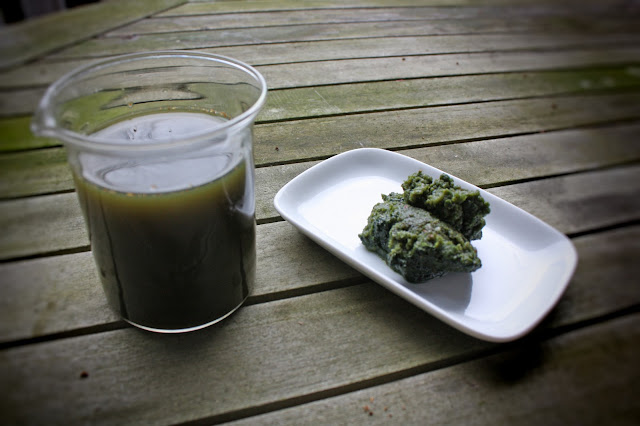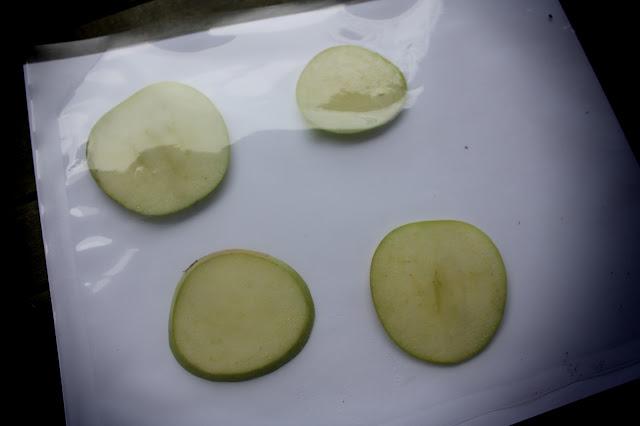She was seeking help on getting "the sear without drying things out, to get things moist without having them just be entropic and crock-pot-y."
Challenge accepted.
There are SO many components that play roles in reducing (or adding to) the crock-pot-yness of a dish that it's understandable why so many people give up and learn to live with blah. What cut of meat do I use? Should I marinate or brine? Do I add fat and if so, when? What are the cooking times and at what temp? Should we just go out to eat instead? These are all questions that need answers and ones that contribute to the finish of any dish regardless of the cooking method employed. There is one overarching technique however that stands alone in its consistently moist, easy to pull off, error-free, and no-holds-barred guarantee in hearing the magical, "holy crap, that doesn't taste like it came out of a crock pot" from your dining companions. Sous vide.
When I started this blog I told myself that I would never cover sous vide cooking in any detail. Don't get me wrong, this technique is probably the most revolutionary cooking method right after the microwave oven, but is just now starting to be adopted by the general public. It's the one technique that I use probably more than any other, not just for its consistent outcome but also for its ridiculously easy setup, and lack of monitoring with perfect results every time. That being said, it's also one of the most heavily blogged about of the Modernist cooking techniques and therefore one I didn't feel was apropos for a blog that aims to introduce readers to "new things".
That being said my friend had a problem and I had a solution. Surely there was a way I could find a compromise to satisfy both of our "needs". The easy route would have been to tell her to buy a Polyscience immersion circulator ($799), an ARY chamber vac ($999), a leg of lamb ($30), some "weird" ingredient she could find at an ethnic grocery ($cheap), throw them all together in a vacuum sealed bag, set it in a water bath at 134F (26.5C) for 10-48 hours and eat. Blog post, DONE!
Sure the blog would be done, but rather pointless. I knew it was highly unlikely my friend would actually buy any of the pricey gear I just mentioned but more importantly, even if she would have purchased the gamut, I've yet to set up Google AdSense on my website to get the "kickbacks" these purchases would bring, making it a no-gain post for me. In light of zero income generation possibilities I decided to take the more time consuming, "high road" and develop a cheaper, but equally delicious, home recipe that would introduce any readers still in the dark not only to the concept of sous vide cooking but one that also showcased an awesome "new" ingredient for my blog (gotta stick to the rules). I also wanted something that could easily be prepared at home with no capital (and very little time) investment.....at least until I get my readership high enough to justify that Google AdSense thing and cash-in on those culinary equipment kickbacks.
Cooking method, check. The only remaining questions were what 'new' ingredient I was going to feature and what other foods were going to take a warm bath with it? There's a decent little Mexican market near my house that seemed like the perfect place to find an accomplice to join me in my sous vide adventure. I wasn't expecting to discover any unique, Mexican specialties here such as escamoles (ant larvae) or chapulines (grasshoppers) and even if I had, I'm pretty sure that cooking them long and slow in a bag wouldn't be the ideal method of bringing out their best. I was, however, certain that I'd find some interesting herbs, vegetables or at the very least, unique chiles that I could make work for this challenge. After spending what seemed like an hour, and I'm sure to the bewildered shop keeper like a day, looking, smelling, and when the owner would turn her head to sell a Mexican Calling Card, tasting various components that looked promising, I landed on fresh Epazote.
Epazote is a Mexcian herb that I put in the Cilantro league. Also known by the alluring names Wormseed, Stinkweed or West Indian Goosefoot (by no means to be confused with East Indian Goosefoot) Epazote, has nothing taxonomically in common with Cilantro. I lump these two together because like Cilantro, Epazote is a food that some people adore while others can't even stand being in the same time zone with.
Epazote Leaves
Personally I love the powerful taste that seems to change over the course of chewing but admit it can be a frustratingly 'tip of your tongue' kind of flavor. You're certain you know what it tastes like but just can't quite think of the word. I've heard the flavor compared to parsley, celery, anise, tarragon, root beer, creosote, turpentine and gasoline. All correct answers but all wrong too. It's not that all of these differnet flavors are competing with each other at the same time but more that your head keeps jumping around thinking it's one flavor and then the next second that it's something else. Total herbal mind F%k.
In Mexico, Epazote is frequently used in bean dishes, moles and stews. The symbiotic pairing with beans is due the legumes mellowing prowess on Epazote's strong flavor AND Epazote's role as a carminative (gas reducer) on the beans. Simply adding a finely chopped handful of this herb to any standard out-of-the-can bean dish can bring a new dimension (and less flatulence) to an otherwise boring side. No sous vide required.
Epazote and Beans -You complete me XOXO
My mission: to incorporate Epazote in a dish that A: used sous vide as the primary cooking method while keeping the process practical for the average home cook, B: didn't overpower the headline ingredient (whatever that was going to be) with the taste of creosote, and C: didn't hide the unique taste of the herb either.
As for the main ingredient I knew that red meat, particularly tough cuts such as short rib or shoulder were out of the question for this job. Preparing these types of cuts are where sous vide cooking really shines, but unfortunately inappropriate for this challenge because of the exceptionally long cooking times required. Even though I was confident my friend wasn't willing to shell out nearly two grand on new kitchen equipment, I was absolutely positive she wasn't game for sitting in front of her 'peasant' stove for 72 hours monitoring the temperature of a pot of water. This had to be quick.
A lot of people wonder why cooking times need to be so long for certain cuts of meat. Does it really take 3 days to heat up spare ribs in a water bath? In a nutshell, no. Depending on its thickness, most cuts of meat prepared sous vide will be fully cooked in several hours. Fully cooked yes, tender and unlike the crock pot crap we're trying to avoid in the first place? No. The seemingly excessive times some meats need to spend at a held temperature is what breaks down the collagen within the meat. Over time the collagen fibers are converted to gelatin and in the process the meat acquires a melt in your mouth texture impossible to achieve by any other method. As an added bonus the meat is held within a sealed bag during the entire process, preventing moisture from evaporating or dripping away. These long cooking times can be sped up to some degree by increasing the temperature of the bath, but with the negative effect of contracting to collagen TOO quickly and wringing additional moisture from the meat. While this wouldn't necessarily dry the meat to crock-potty levels it certainly isn't a good idea and one we will avoid all together for this post.
Collagen Breakdown
Short animation I created showing the breakdown of collagen and moisture loss at different cooking temperatures and times.
Seafood, on the other hand, can also be cooked precisely with sous vide and in MUCH shorter periods of time. Cooking fish perfectly would only require my friend to periodically monitor the temperature of her water bath for about 25 minutes. In a society that on average watches 34 hours of television per week, 28 of which seemingly involves a Kardashian, "sacrificing" half an hour to make a restaurant quality meal seemed like a reasonable request.
Cooking Method Comparison
Short animation I created that shows the difference in thermal transfer between sous vide and conduction cooking methods.
salmon sous vide, epazote, pinto bean foam, tomatillo salsa, salmon skin chip
Prepare brine
Mix together
2 cups water
4TB Salt
2TB Sugar
Submerge salmon in brine and chill for 1 hour. Brining will firm the flesh as well as remove the albumin. Albumin doesn't effect the taste of the dish but it will congeal during cooking and make that white gunky stuff you may have seen on cooked salmon before.
Place brined salmon in a Zip Lock bag. With the bag still unsealed, dunk in water as far down as possible without allowing any water to breach the top. The pressure of the water will force the majority of air from the bag (displacement) and THEN zip the bag shut.
Prepare the sous vide bath and monitor temperature to maintain 140F. If the temperature goes above your target, reduce the
heat slightly or/add additional cold water. If the temperature falls
below your target...duh...turn up the heat.
Cook sous vide at 140F for 25 minutes, maintaining target temperature as accurately as practical.
Pinto Bean Foam
Combine in pressure cooker
3/4 cup (150g) dry pinto beans
1 2/3 cup (400g) water
2 1/4 tsp (10g) lard
 Add 1/2 cup (100g) of heavy cream to blended beans. Reheat and add chopped epazote and salt to taste.
Add 1/2 cup (100g) of heavy cream to blended beans. Reheat and add chopped epazote and salt to taste.
3/4 cup (150g) dry pinto beans
1 2/3 cup (400g) water
2 1/4 tsp (10g) lard
Pressure cook for 1 hour at 15psi (High if using an electric model)
Blend until smooth
Rough chop Epazote
 Add 1/2 cup (100g) of heavy cream to blended beans. Reheat and add chopped epazote and salt to taste.
Add 1/2 cup (100g) of heavy cream to blended beans. Reheat and add chopped epazote and salt to taste.
Place mixture in whipping siphon and charge with 3 cartridges of nitrous oxide.
tomatillo, epazote salsa
Husk and rinse tomatillos. Place on baking sheet.
Blend roasted tomatillos and salt to taste
Add fresh chopped epazote.
finish
The only caveat to sous vide cooking is keeping in mind that foods will not "brown" in the bag (or in kitchen-talk, no Maillard Reaction) Fortunately there's a simple fix. Heat a pan on high and add a small amount of high temperature oil such as peanut. Sear the salmon, skin side down until crisp and brown.
Portion salmon and place next to pinto foam. Top with tomatillo, epazote salsa and additional fried salmon skin for texture. Serve with remaining salsa on side for any hard core epazote fans.






































